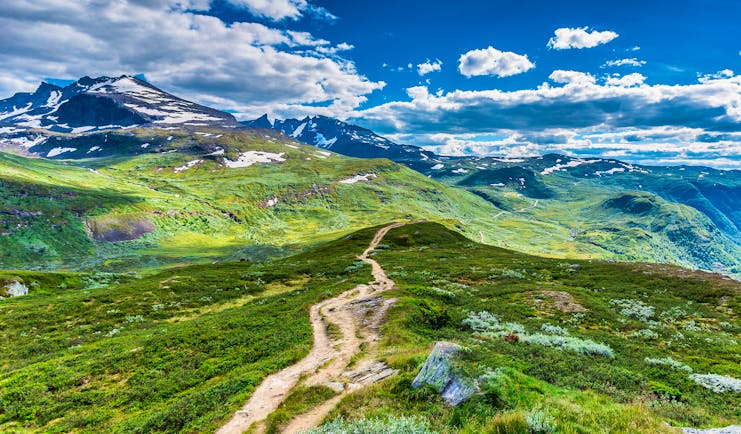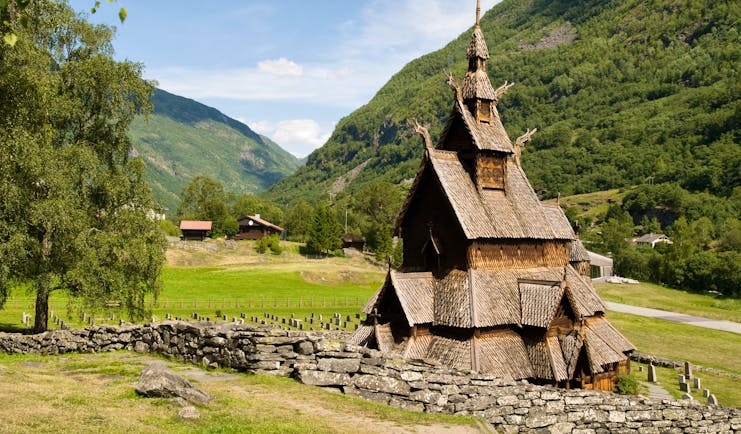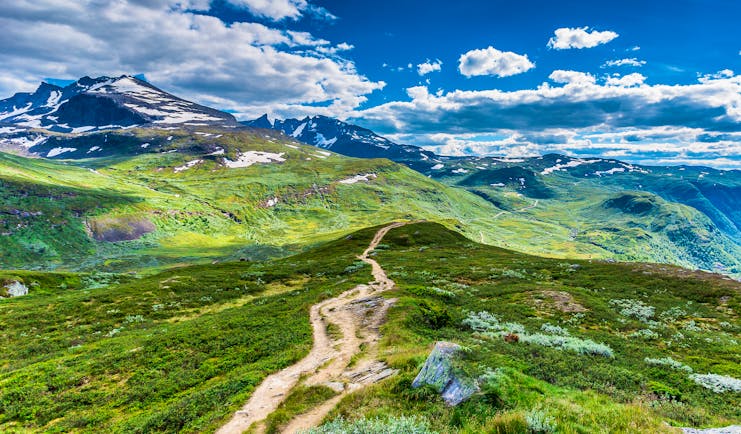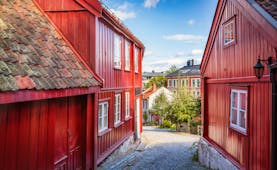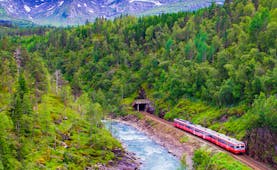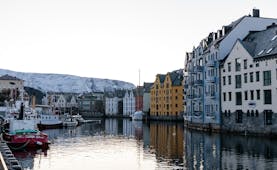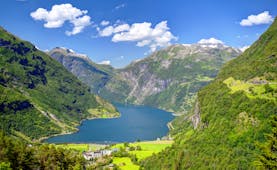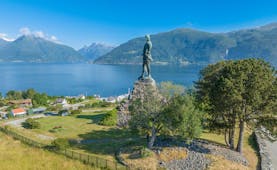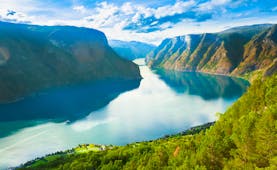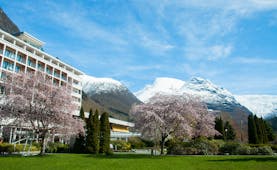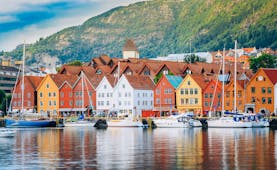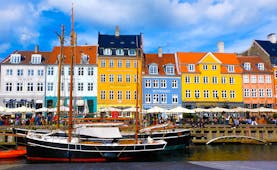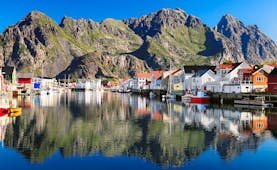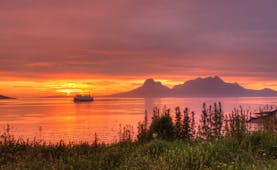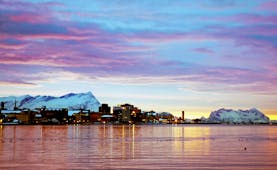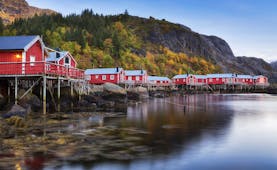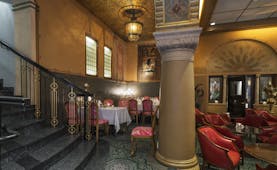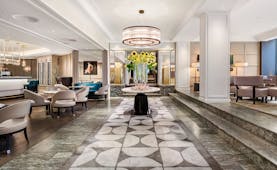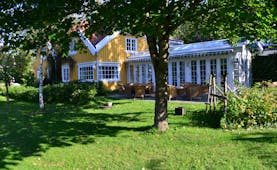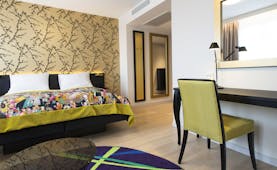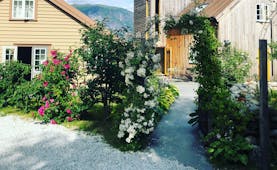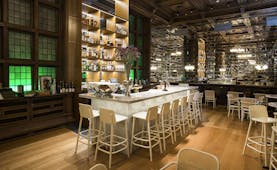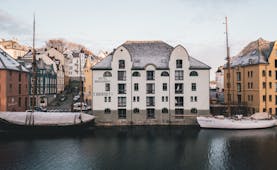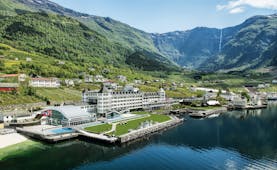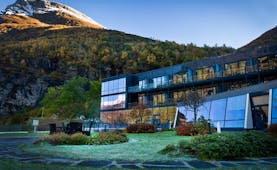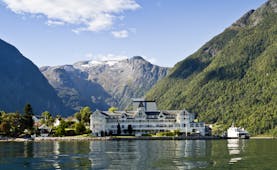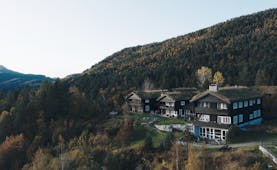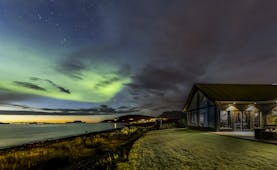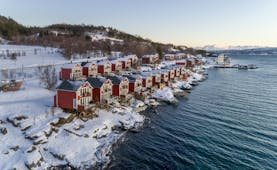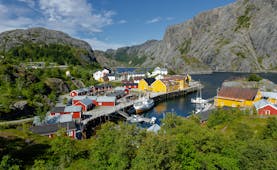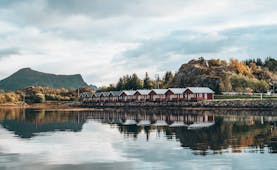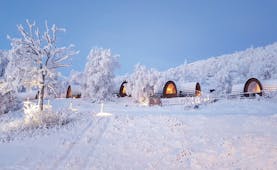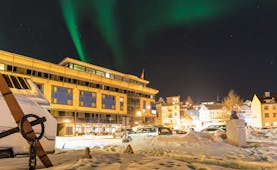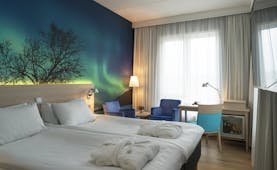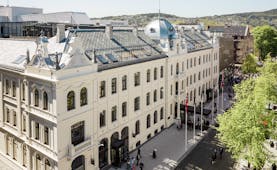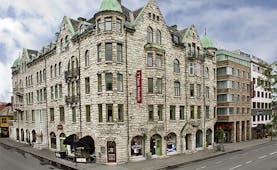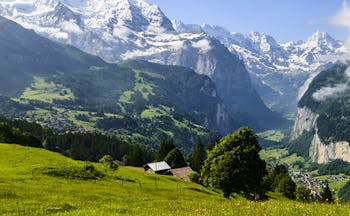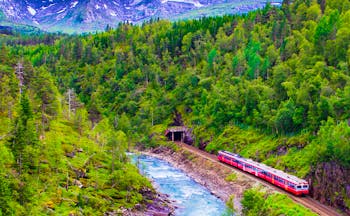Luxury 11-night Norway fly-drive holiday with 4 nights on the Aurlandsfjord and 4 nights by the Jotunheimen National Park
This luxury fly-drive holiday introduces you to two examples of the best of Norway’s scenery: the mountainous national park and the majestic fjords. Start by flying into Oslo and driving through the heart of Norway to the Aurlandsfjord at the southern end of the majestic Sognefjord and then on to the Jotunheimen National Park. The Aurlandsfjord area gives you access to spectacular scenery and also historic Viking settlements.There are all sorts of water-based activities too. Jotunheimen features an incredible number of hiking trails as well as the 23 highest mountains in the country, including Galdhøpiggen, the highest in Norway, and the reason behind its nickname of the Home of the Giants. Spend your time here exploring the beautiful scenic routes up to the peaks and even across glaciers, including the famous Bessegen ridge hike, or else closer to the ground canyoning and kayaking on the River Sjoa. At the end of your holiday you drive through the picturesque Gudbrandsdalen.
Highlights
Oslo • Aurlandsfjord • Tindevegen scenic road • Jotunheimen • Lillehammer
Day by day
Your holiday starts with your arrival in Oslo for two nights.
The capital of Norway, Oslo, sits on the country’s southern coast at the head of the Oslofjord. Explore the national museums located in the Bygdøy Peninsula: the Fram Museum, the Norwegian Folk Museum, the Norwegian Maritim Museum, the Viking Museum and the Kon-Tiki Museum. The Fram Museum displays the strongest wooden ship ever built which still holds the record for sailing farthest south and the farthest north. The Norwegian Folk Museum is an open-air attraction showcasing the diverse wooden architecture and history of the country and its traditions. For a further insight into the history of Oslo in particular, visit Akershus Castle and Fortress. Completed during the 1300s, this mediaeval castle’s strategic location at the end of the headland enabled it to withstand every siege throughout the ages. At the castle is also the poignant Norwegian Resistance Museum. Oslo is also known for its green spaces, the most famous of which is Frogner Park, home to Vigeland Sculpture Park. This features more than 200 sculptures in bronze, granite and iron and is one of Norway’s top tourist attractions. Housed in some beautiful gardens of its own, the Royal Palace is the official seat of the Norwegian King and Queen.
Today you collect your hire car and drive north-west through initially the pretty rolling fields and pine trees north of Oslo passing through historic towns, many with charming churches such as Bromma. You pass through the town of Gol, with an open-air museum that contains a replica of the town’s 13th century stave church. Closer to Aurland, you reach Borgund, home of another famous stave church, dating from about 1200. The last part of your route is through the Laerdal tunnel, or you can take the old route, the National Tourist Route Aurlandsfjellet, over the top of the mountains (allow more time). This road is open usually from 1 June until 15 October and is 1,306 metres above sea level at its highest point. The most direct route from Oslo to Aurland takes about 5 hours so you will need all day, allowing for stops to visit places of interest. You have four nights in Aurland.
The location of your hotel is perfect for exploring the southern part of the Sognefjord. Aurland is a fjord-side village surrounded by lush countryside. Boat trips on the fjord are possible and you can take a ferry to Flåm for a ride on the famous Flåmsbana. There is an annual jazz festival one weekend in May. Nearby you can also walk in the mountains of the Aurlandsdalen and fish in the fjord. You can visit the fjord by rib-boat too. At Gudvangen are the white caves, there the Sogn Folk Museum in Kaupanger and the famous Stegastein viewpoint at 650 metres above the fjord on the road over the Aurlandsfjell mountain. The area is also rich in Viking heritage, and there are several burial mounds in the village. In the Viking village of Njardarheimr you experience life in the area one thousand years ago. There is also a shoemaker’s museum at Aurland.
Today you leave the Aurlandsfjord to drive northwards to the Jotunheimen National Park. The journey can take as little as three hours if you use the Laerdal tunnel but for the scenic journey between June and October, you can take the old road over the mountains. From Laerdal the road hugs the side of the Sognefjord and then the Årdalsvatnet. You might want to stop for a coffee or fuel in Øvre Årdal before the road zig zags out of the valley above the Tindevegen waterfall. Much of this road is single track with passing points. This is the Tindevegen high mountain panorama road which is an automatic toll road (NOK 90). The road is paved but narrow and steep; it is open from May until November. As the road meanders through the mountains there are viewpoints and some places to stop. Views of the Hurrungane peaks and Store Skagastølstind mountain in the east and the Sognefjord and Skjolden in the west can be had. By the Mefjell parking and picnic place you cross from Vestland to Innlandet. To your east and north-east is the mountain range and peaks of Galdhøppigen and the Jotunheimen mountains.
Situated in Eastern Norway between Oslo, Bergen and Trondheim, Jotunheimen National Park covers an area of roughly 3,500 square km and is home to some of the most famous hiking trails in the country. The area was originally known as the Home of the Giants in Norse mythology due to the fact that Norway’s 23 highest mountains are all located within its borders. The two highest of these are also the focal points of two of Norway’s top three most iconic hikes. A popular starting point for the Galdhøppigen hike is Spiterstulen Mountain Lodge, which lies 1,100 metres above sea level. From here the round trip is roughly 13 km long and usually takes 5-7 hours, reaching three peaks over 2,000 metres high. Start by crossing the bridge at Spiterstulen, following a clear path which was renovated by Sherpas in 2010 through the forest. Following the red “T”s which mark the trail, you will ascend first Svellnose, then Keilhaustopp, before eventually reaching Galdhøppigen at 2,469 metres above sea level. You may want to stop at the Spiterstulen Mountain Lodge again on your way back for an authentic evening meal before returning to your hotel for the night. Spiterstulen is also one of the main starting points for the hike up the second highest mountain in Norway, Glittertind. This mountain has a permanent snow-cap and involves crossing the Glitterbrean Glacier. It is important to check the weather conditions before embarking on this hike, as crampons may be required depending on the conditions on the final ascent. For those looking for a more challenging, yet perhaps even more scenic, hiking route, the Bessegen ridge hike is recommended for experienced hikers only and starts with a scenic 20-minute ferry ridge from Gjendesheim to Memurubu. Jotunheimen is home to over 50 marked trails and you will find roughly 70 more in the surrounding area, meaning there is something to suit all ages and ability levels. On the opposite end of the altitude scale, the Dumma Valley features a series of labyrinthine caves home to narrow passageways and underground waterfalls carved out by the River Dumma. Other popular activities here include climbing and rafting. The River Sjoa is considered the best river in Norway for rafting, and there are also options to go canyoning and river boarding on the crystal blue waters. The town of Lom is a picturesque settlement famous for its striking Stave Church, which is one of the biggest of its kind in Norway and dates back to 1158. Other attractions here are the Lom open-air museum and the Norwegian Mountain Centre, which features an exhibition about Vikings, folklore and fairy-tales of the region. No visit to this town would be complete without a visit to the Lom Bakery to try one of its country-renowned cinnamon buns.
You leave the Home of the Giants today to drive south in the direction of Oslo but stopping for a night near Lillehammer. You pass through the picturesque Gudbrandsdalen and should stop to visit the famous stave church at Ringebu. This church is one of the most famous in Norway and dates from about 1220. It was constructed traditionally without the use of a single nail but instead the wood is dovetailed, and tar was used to protect the timber. Nearby is the Ringebu Rectory, dating from 1743, and an historic experience in its own right. The driving time is about three hours.
It takes about 90 minutes to drive from Lillehammer to Oslo airport today so time your departure for your flight. Return your hire-car to the airport.
We have just arrived home after what has been a wonderful holiday to Norway. Thank you for everything you have done to arrange it for us. All the arrangements worked out very well and all the hotels were exceptional in their own way. We particularly appreciated the personal touches which were evident throughout the tripMr and Mrs F, June 2025
Holiday price guide From £2,660 per person
Holiday Code SCFD05
Call us on 01392 441245
Luxury 11-night Norway fly-drive holiday with 4 nights on the Aurlandsfjord and 4 nights by the Jotunheimen National Park
Your holiday starts with your arrival in Oslo for two nights.
The capital of Norway, Oslo, sits on the country’s southern coast at the head of the Oslofjord. Explore the national museums located in the Bygdøy Peninsula: the Fram Museum, the Norwegian Folk Museum, the Norwegian Maritim Museum, the Viking Museum and the Kon-Tiki Museum. The Fram Museum displays the strongest wooden ship ever built which still holds the record for sailing farthest south and the farthest north. The Norwegian Folk Museum is an open-air attraction showcasing the diverse wooden architecture and history of the country and its traditions. For a further insight into the history of Oslo in particular, visit Akershus Castle and Fortress. Completed during the 1300s, this mediaeval castle’s strategic location at the end of the headland enabled it to withstand every siege throughout the ages. At the castle is also the poignant Norwegian Resistance Museum. Oslo is also known for its green spaces, the most famous of which is Frogner Park, home to Vigeland Sculpture Park. This features more than 200 sculptures in bronze, granite and iron and is one of Norway’s top tourist attractions. Housed in some beautiful gardens of its own, the Royal Palace is the official seat of the Norwegian King and Queen.
Today you collect your hire car and drive north-west through initially the pretty rolling fields and pine trees north of Oslo passing through historic towns, many with charming churches such as Bromma. You pass through the town of Gol, with an open-air museum that contains a replica of the town’s 13th century stave church. Closer to Aurland, you reach Borgund, home of another famous stave church, dating from about 1200. The last part of your route is through the Laerdal tunnel, or you can take the old route, the National Tourist Route Aurlandsfjellet, over the top of the mountains (allow more time). This road is open usually from 1 June until 15 October and is 1,306 metres above sea level at its highest point. The most direct route from Oslo to Aurland takes about 5 hours so you will need all day, allowing for stops to visit places of interest. You have four nights in Aurland.
The location of your hotel is perfect for exploring the southern part of the Sognefjord. Aurland is a fjord-side village surrounded by lush countryside. Boat trips on the fjord are possible and you can take a ferry to Flåm for a ride on the famous Flåmsbana. There is an annual jazz festival one weekend in May. Nearby you can also walk in the mountains of the Aurlandsdalen and fish in the fjord. You can visit the fjord by rib-boat too. At Gudvangen are the white caves, there the Sogn Folk Museum in Kaupanger and the famous Stegastein viewpoint at 650 metres above the fjord on the road over the Aurlandsfjell mountain. The area is also rich in Viking heritage, and there are several burial mounds in the village. In the Viking village of Njardarheimr you experience life in the area one thousand years ago. There is also a shoemaker’s museum at Aurland.
Today you leave the Aurlandsfjord to drive northwards to the Jotunheimen National Park. The journey can take as little as three hours if you use the Laerdal tunnel but for the scenic journey between June and October, you can take the old road over the mountains. From Laerdal the road hugs the side of the Sognefjord and then the Årdalsvatnet. You might want to stop for a coffee or fuel in Øvre Årdal before the road zig zags out of the valley above the Tindevegen waterfall. Much of this road is single track with passing points. This is the Tindevegen high mountain panorama road which is an automatic toll road (NOK 90). The road is paved but narrow and steep; it is open from May until November. As the road meanders through the mountains there are viewpoints and some places to stop. Views of the Hurrungane peaks and Store Skagastølstind mountain in the east and the Sognefjord and Skjolden in the west can be had. By the Mefjell parking and picnic place you cross from Vestland to Innlandet. To your east and north-east is the mountain range and peaks of Galdhøppigen and the Jotunheimen mountains.
Situated in Eastern Norway between Oslo, Bergen and Trondheim, Jotunheimen National Park covers an area of roughly 3,500 square km and is home to some of the most famous hiking trails in the country. The area was originally known as the Home of the Giants in Norse mythology due to the fact that Norway’s 23 highest mountains are all located within its borders. The two highest of these are also the focal points of two of Norway’s top three most iconic hikes. A popular starting point for the Galdhøppigen hike is Spiterstulen Mountain Lodge, which lies 1,100 metres above sea level. From here the round trip is roughly 13 km long and usually takes 5-7 hours, reaching three peaks over 2,000 metres high. Start by crossing the bridge at Spiterstulen, following a clear path which was renovated by Sherpas in 2010 through the forest. Following the red “T”s which mark the trail, you will ascend first Svellnose, then Keilhaustopp, before eventually reaching Galdhøppigen at 2,469 metres above sea level. You may want to stop at the Spiterstulen Mountain Lodge again on your way back for an authentic evening meal before returning to your hotel for the night. Spiterstulen is also one of the main starting points for the hike up the second highest mountain in Norway, Glittertind. This mountain has a permanent snow-cap and involves crossing the Glitterbrean Glacier. It is important to check the weather conditions before embarking on this hike, as crampons may be required depending on the conditions on the final ascent. For those looking for a more challenging, yet perhaps even more scenic, hiking route, the Bessegen ridge hike is recommended for experienced hikers only and starts with a scenic 20-minute ferry ridge from Gjendesheim to Memurubu. Jotunheimen is home to over 50 marked trails and you will find roughly 70 more in the surrounding area, meaning there is something to suit all ages and ability levels. On the opposite end of the altitude scale, the Dumma Valley features a series of labyrinthine caves home to narrow passageways and underground waterfalls carved out by the River Dumma. Other popular activities here include climbing and rafting. The River Sjoa is considered the best river in Norway for rafting, and there are also options to go canyoning and river boarding on the crystal blue waters. The town of Lom is a picturesque settlement famous for its striking Stave Church, which is one of the biggest of its kind in Norway and dates back to 1158. Other attractions here are the Lom open-air museum and the Norwegian Mountain Centre, which features an exhibition about Vikings, folklore and fairy-tales of the region. No visit to this town would be complete without a visit to the Lom Bakery to try one of its country-renowned cinnamon buns.
You leave the Home of the Giants today to drive south in the direction of Oslo but stopping for a night near Lillehammer. You pass through the picturesque Gudbrandsdalen and should stop to visit the famous stave church at Ringebu. This church is one of the most famous in Norway and dates from about 1220. It was constructed traditionally without the use of a single nail but instead the wood is dovetailed, and tar was used to protect the timber. Nearby is the Ringebu Rectory, dating from 1743, and an historic experience in its own right. The driving time is about three hours.
It takes about 90 minutes to drive from Lillehammer to Oslo airport today so time your departure for your flight. Return your hire-car to the airport.
We have just arrived home after what has been a wonderful holiday to Norway. Thank you for everything you have done to arrange it for us. All the arrangements worked out very well and all the hotels were exceptional in their own way. We particularly appreciated the personal touches which were evident throughout the tripMr and Mrs F, June 2025
Holiday price guide From £2,660 per person
Holiday Code SCFD05
Our prices include
● Return flights from London to Oslo
● Hire of a group B car for 10 days
● 2 nights’ bed and breakfast in Oslo – choose between Hotel Continental, Amerikalinjen and Hotel
● 4 nights’ bed and breakfast at 29/2 Aurland in a Historic double room
● 4 nights’ bed and breakfast at Elveseter Hotel in a standard double room
● 1 night’s bed and breakfast at a hotel in or near Lillehammer in a standard double room
● Concierge service and Expressions Holidays regional helpful hints
Our prices do not include
● Early check-in or late check-out at any hotels (although we can arrange this on request at additional cost)
● Any other services not mentioned above, such as transfers and meals except breakfast at hotels
● Personal holiday insurance. This is essential and cover should be in place from when you book the holiday.
● Possible local tourist tax, usually the equivalent of £1 to £3 per person per night, and payable locally to the hotel
● Transfers Oslo
Additional information This holiday can be arranged from May to beginning of October. Timings can vary depending on the month and day of the week.
Call us on 01392 441245
Luxury 11-night Norway fly-drive holiday with 4 nights on the Aurlandsfjord and 4 nights by the Jotunheimen National Park

The Hotel Continental is an iconic grand hotel dating from 1900 in the centre of Oslo on Stortingsgaten. A 5-star hotel, it offers 151 elegant rooms and suites and excellent dining.
Standard room

The Amerikalinjen is a traditional yet trendy 4-star hotel in downtown Oslo. Light, modern rooms, four restaurants/bars and a large library.
Standard room
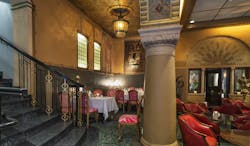
The Hotel Bristol Oslo is a traditional, 4-star, grand hotel in the centre of Oslo a short walk from well-known attractions in the city including Akershus Fortress.
Standard room
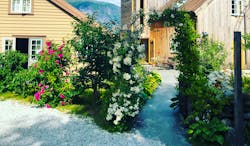
A traditional, boutique hotel set amongst the rolling hills and gentle waters of the fjords. Uniquely-appointed rooms and bespoke activities on offer.
Historic room
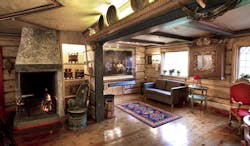
The Elveseter Hotel is a traditional family-run hotel on the edge of the Jotunheimen National Park in central Norway. Simple yet comfortable rooms, restaurant, and access to a large number of activities nearby.
Standard room
We have just arrived home after what has been a wonderful holiday to Norway. Thank you for everything you have done to arrange it for us. All the arrangements worked out very well and all the hotels were exceptional in their own way. We particularly appreciated the personal touches which were evident throughout the tripMr and Mrs F, June 2025
Holiday price guide From £2,660 per person
Holiday Code SCFD05
Call us on 01392 441245
Luxury 11-night Norway fly-drive holiday with 4 nights on the Aurlandsfjord and 4 nights by the Jotunheimen National Park
About Oslo and Oslofjord
Norway's capital city, Oslo, nestles at the end of the Oslofjord surrounded by hills and islands. Oslo blends skilfully tradition and modernity. The iconic Oslo Opera House on the waterfront sits a short distance from the Akershus fortress and the Old Town Hall dating from 1641 is a stroll away from the Akrobaten pedestrian bridge, a near-futuristic construction of steel and glass. Much of Oslo is within walking distance from the centre and you can explore happily on foot for much of your stay. You'll notice that cars are very much absent from the centre and that trams are a very easy way of reaching places on the outskirts. A fast train serves the airport and there are numerous ferries from the harbour in front of the town hall that take you to the islands in the fjord and to historic villages along the coast.
Highlights of Oslo
Waterfront, Opera House, Akershus Fortress, Norwegian Resistance Museum, Frogner Park, Bydoy and its museums, Oslo city museum, Fjord cruise
Cultural highlights of Oslo
Munch museum, National museum, Viking Ship Museum, Kon-Tiki Museum, Astrup Fearnley Museum
Festivals of Oslo
Norwegian Wood music festival in June, Oslo World music festival, Christmas, Easter, Oslo Medieval Festival at the end of May, Oslo Chamber Music festival held in August, Oslo Jazz Festival held in August, Holmenkollen ski festival
Gastronomy of Oslo
Seafood of all sorts as well as game
Call us on 01392 441245
Luxury 11-night Norway fly-drive holiday with 4 nights on the Aurlandsfjord and 4 nights by the Jotunheimen National Park
About Vestlandet and Norway's fjordland
Vestlandet contains many of the archetypal sites the visitor associates with Norway: spectacular fjords, colourful fishing ports, stave churches and dramatic panoramas. Vestlandet is a long, thin region in the west of the country, bordering the North Sea and interspersed by jagged inlets from the sea into the mountainous interior: the fjords including Sognefjorden, Geirangerfjord, Lysefjorden, Hardangerfjorden and Eidfjord. Bergen is the outstanding jewel as a town in this region, a World Heritage City, with ancient history, attractive buildings, world-class museums and superb restaurants. Sognefjord is Norway’s longest and deepest fjord and is composed of five large arms with fingers, of which Naeroyfjorden is a UNESCO World Heritage Site. To complement the dramatic natural scenery, there are ample man-made delights in the area too, with charming villages, waterfronts, well-preserved Viking heritage sites and local foodie specialities. You can witness the drama of the Sognefjord by boat from Bergen to Flam on a journey of about five hours. Just north and south of the innermost reaches of the Sognefjord are the outstanding stave churches of Borgund, unchanged since the Middle Ages, and Urnes, the oldest stave church in Norway. The Geirangerfjord is one of the best-known and justifiably so as it contains ten miles of dramatic natural beauty with numerous waterfalls tumbling down the vertical cliff face. The Hardangerfjord runs from the North Sea to the Hardangervidda Plateau and offers a wealth of attractive scenery and pretty towns, with numerous activities. There are also apple orchards and farmland, hiking and cycling. Towards the north of the region is the coastal town of Alesund, whose centre consists mainly of striking Art Nouveau buildings, constructed in the early 20th Century after a fire destroyed most of the old town centre.
Highlights of Vestlandet
Vestlandet is fjord country and the most well-known and spectactular are Sognefjorden, the Geirangerfjord, Lysefjorden, Hardangerfjorden and Eidfjord. The seafaring cities and ports of Bergen and Alesund offer a mixture of cultural, food and sightseeing possibilities. Bergen has the UNESCO World Heritage site of Bryggen with museum, shops, galleries and restaurants. There is the KODE museum of art and design and at Troldhaugen you can visit the home of Edvard Grieg. The region is also home to the Flam railway and cable cars take you to mountain tops. Alesund is renowned as an Art Deco town after a fire in 1904 destroyed the old town. From here it is the gateway to the Geirangerfjord and the Trollstigen mountain road. Combine land and water sports as well as spectacular scenery in Vestlandet. You can also visit glaciers in this region and take the Atlantic Road for coastal vistas.
Cultural highlights of Vestlandet
There is a wide range of cultural visits throughout the region: KUBE art nouveau centre in Alesund, Agatunet traditional Norwegian village on the Hardangerfjord, Kinn stone church from the Middle Ages, Alesund medieval age museum, The Vicarage at Nesset childhood home of Nobel Prize for Literature winner Bjornson, Bergenhus Fortress in Bergen, Suldal living museum farm, Eldhuset at Undredal on the Sognfjord showing local traditions, pasture farming and goat's cheese production, Sirdal mountain musuem, Bergen school museum, Geirganger timber church, Flam railway museum, Steffagarden on Ona croft from 1793, Visnes mining museum, Hardanger fold museum, Baroniet Rosendal manor house and gardens, Viking exhbition at Eidfjord, Vik historical tour, Kaupanger stave church on the Sognefjord, Trollveggen visitor centre, Viking village at Gudvangen, Borgund church, Osteroy museum, Ardal old church Ryfylke.
Festivals of Vestlandet
Kristiansund has a food festival in June, there is a Viking festival in Avaldsnes in June, Sola holds a kite festival in June, Floro holds the world's longest herring table in June, early July sees the Skudefestivalen the largest gathering of coastal culture in western Norway, Floro holds a sea sports festival in mid July, Molde holds the oldest continuously running jazz festival in the world in July, Haugesund harbour days is a yearly tradition in mid August, The Tomato festival is held in mid August at Finnoy on the Ryfylke Islands near Stavanger, Hardanger holds a music festival at the end of August, Bergen has a food festival at the beginning of September.
Gastronomy of Vestlandet
The mild climate and soils of the region lend themselves to the growing of fruit and berries that produce apple juice, cider and jams. Strawberries, raspberries and cherries are also grown locally. Cheeses are produced in the region including the Tingvoll cheese that has been produced here since 1303. Smoked salmon and cured meats are also local. Clipfish (dried salted cod) in the Alsesund area.

